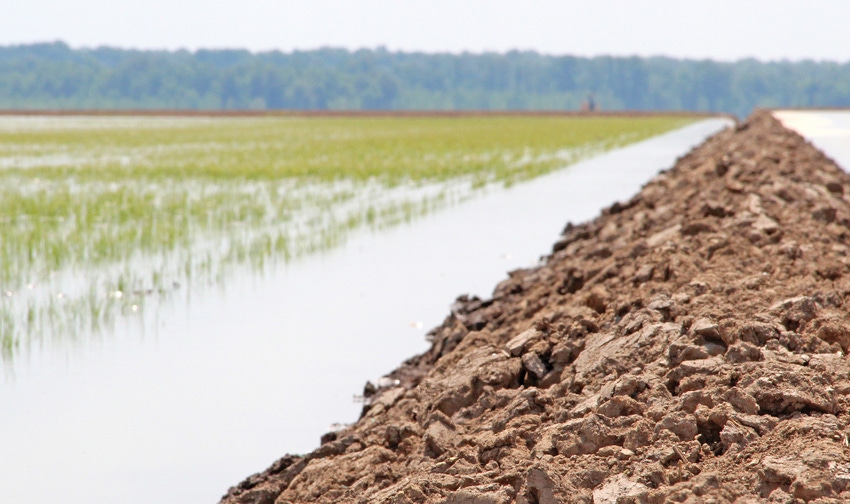May 25, 2013

Akiochi disease of rice, also known as ‘hydrogen sulfide toxicity’, causes black crown and root rot in rice. In 2012, under hot and dry conditions, the disease was seen in several rice fields across the state of Arkansas. In the assessment of former Extension rice pathologist Dr. Rick Cartwright, incidence of this disease in 2012 was the most severe since 2004.
We do not know exactly which weather factors play a role in the incidence and prevalence of this disease. In light of this, several important questions remain unanswered: 1) Why was this disease severe in 2004 and even more so in 2012, but not in the years between? The 2012 season was hot and dry and crops were early, but 2013 is wet and cold and rice is late. 2) Since the two seasons are very different, should we even be concerned about fields that had the problem last year?
At the moment, we do not have strong evidence to provide clear information about the prevalence of the disease in relation to weather. Dr. Cartwright and Dr. Chuck Wilson observed this problem in previous years in fields with and without a history of the disease. In their experience, they have not seen any relationship between this disease and weather. In 2012, some rice producers saw the problem for the first time in fields that had not been tilled for several years. A couple of fields that reported the problem had been winter-flooded for waterfowl the previous fall.
Check Rough Rice Futures Prices
The cause of the disease is not fully understood. The major culprit is the formation of hydrogen sulfide in some soil types. Research has indicated hydrogen sulfide, even in low concentrations, can be toxic to roots and will affect the plant’s ability to take up nutrients from the soil. Fertilizer applications will not provide the desired benefit to plants with compromised root systems.
Cold water and iron from wells were also thought to aggravate the situation. Although the disease appeared worse near the wells, it was also severe in spots far from wells. Some soils with the problem have also shown higher pH. Preliminary greenhouse experiments in soil collected from a problematic field showed severe black root rot in test plants similar to that observed in the field (Photo A).

Photo A: Rice roots rotting from Akiochi disease in a greenhouse test
Problematic rice fields show yellowish lower leaves (Photo B) a few weeks after flooding and plant growth is slower than normal. If you know your field has a history or if you are suspicious of the problem, it is wise to pull out a few plants to compare rice roots from the levee and the bay. Rice growing on levees is usually less affected due to more aerobic soil conditions (Photos C, D). In severe cases, opportunistic fungi grow in the root crown and block the passageway (Photo C) to the stem and the rest of plant. Ultimately the plant dies. Preliminary greenhouse tests showed up to 30 percent plant death on rice planted in problematic soil after flooding. To the best of our understanding, the fungi that grow in the crown do not appear to be the cause for root rot. They may simply be taking advantage of the already weakened plant to feed on the dead tissue, which is the case in several opportunistic fungi.

Photo B: Field with Akiochi disease, Hunter, AR
To reduce the risk of this disease, begin scouting your fields two weeks after permanent flooding, especially in fields with a history of the disease. If you are suspicious of any of your fields, you need to scout. Be thoughtful and careful managing this disease. If you already know your field has a history of the disease, follow the “preventative strategy”, i.e., DRAIN and DRY as you do for straighthead at straighthead timing based on the DD50 for the field, then re-flood once you see new roots start forming. However, if symptoms are detected unexpectedly and before heading, you can try a “rescue strategy”, i.e., carefully drain the field to expose the soil without allowing the soil to fully dry.
Ag news delivered daily to your inbox: Subscribe to Delta Farm Press Daily.
Once you see new roots actively growing, re-flood the field. The principle behind these strategies is to aerate the soil so that oxygen gets to the roots. It is critical to not to damage the crop from water shortage when attempting such practices so you will need to think about the risks beforehand.

Photo C: Rice plant with Akiochi disease pulled from the bay

Photo D: unaffected plant pulled from the levee (D)
Remember, plants use the highest amount of water during reproductive stages. “Draining and drying” may not be the best option for producers that have limited water resources or in really large fields. However, if left unmanaged, particularly on an early affected rice, the crop may not make it to harvest. Remember to also balance fertilizer based on a recent soil test and Extension recommendations. Phosphorus helps to enhance root vigor and potassium the overall health.
Please refer to the following link for additional information.
You might also read:
5 major trends pose threat to American farming
You May Also Like




